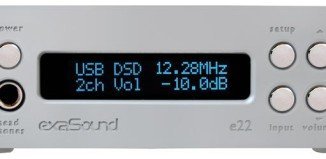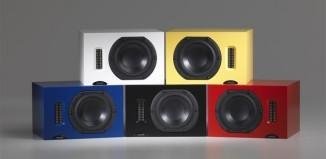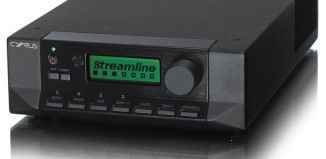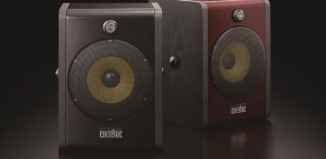
Booming flat panel TV sales of the last few years combined with the increasing popularity of the Blu-ray disc format have sparked consumer interest in A/V receivers, among first-time buyers and those looking to upgrade an aging model. That’s because in order to get the most out of your flat panel TV, Blu-ray player and other video sources you’ll need a modern A/V receiver to tie it all together. Although today a good A/V receiver that has the most essential features can be had for just a few hundred dollars, if you want a powerful model with the latest advancements, you’ll have to look at the higher models in each manufacturer’s receiver line-up. Earlier this year I had the privilege of spending some time with the Onkyo TX-SR876, the company’s second from the top A/V receiver, which retails for approximately $2099 CDN.
The TX-SR876 offers the most comprehensive feature list of any A/V receiver that’s made a stop in the CANADA HiFi lab. This THX Ultra2 Plus certified receiver delivers 140 watts of power to each of its seven channels of amplification, and is designed to drive speakers with 4 to 8 ohm loads. On-board HQV Reon-VX video processing can up-scale and/or deinterlace sources to 480p, 720p, 1080i, or 1080p on the HDMI output and up-scale/deinterlace up to 1080i on the component output. The TX-SR876 is one of the first receivers to incorporate ISF (Imaging Science Foundation) video calibration, which allows an ISF-certified calibrator to optimize its performance with each of the connected sources. Picture elements such as brightness, contrast, hue, saturation, gamma and various levels of noise reduction can all be fined tuned in the receiver’s menu. For those who wish to use the receiver with two displays, for example a plasma TV and a projector, the TX-SR876 offers two HDMI outputs. As expected from a modern receiver, this model decodes all of the latest audio formats including Dolby TrueHD and DTS-HD Master Audio. To improve the sound in your specific room, the TX-SR876 utilizes Audyssey’s MultEQ XT technology to measure and correct sound distortion caused by room acoustics. Topping up the feature list is an AM/FM tuner and XM and Sirius capability. The receiver’s suite of video inputs includes 4 HDMI (ver 1.3a), 3 component video, 6 S-video and 6 composite video. There are 9 RCA audio inputs, 1 phono input (for turntables) as well as 7.1 multi-channel analog inputs.
The front panel of the TX-SR876 has a clean, familiar Onkyo look that hasn’t changed in the last few generations. Some buttons are present on the front panel, while most are hidden behind a large flap door. Weighing in at a hefty 50.9 pounds, this is the heaviest receiver that I’ve reviewed to date. The supplied remote is fully backlit (hurray!) and provides comfortable operation of the receiver.
My review setup consisted of the familiar suspects including a Pioneer PDP-6020FD KURO plasma TV, a Pioneer Elite BDP-95FD Blu-ray player and KEF iQ speakers. I also connected our reference Epson PowerLite Home Cinema 1080 UB projector to the receiver’s second HDMI output and projected the image on to an Elite Screens Home90IWH2 90-inch screen. All connections were made with HDMI cables.
The TX-SR876’s on-screen menu system has received a significant visual upgrade from previous generations of Onkyo receivers. The menus are now presented in colour with some graphics, instead of the basic white text on a black background. However, the look of the menu system still lags behind the competition since it’s displayed only at the 480p resolution - other high-end competitors now display the menus at 1080p.
The dual HDMI output is an absolute must have feature for those with two displays. Unfortunately, the HDMI output cannot be switched using the remote - a button behind the receiver’s front panel flap door is the only way to change the output. This seems like a major oversight on Onkyo’s part because it’s a real hassle to have to get off the couch just to change the output.
I started the review session with The Dark Knight on Blu-ray, a fantastic demo movie for any worthy home theatre system. Shattering of the glass in the opening scene sounded so realistic, it made me jump in my seat. The bank robbers’ voices were convincingly muffled by the masks on their faces, yet detailed and distinctive, compared to all the other characters. The blasts from the bank manager’s shotgun sounded frighteningly powerful and echoed in the airy atmosphere of the bank. It was clear right from the start that this receiver had a sweet spot for power-loaded Hollywood action sequences. The TX-SR876 had no hesitation in throwing me right in the middle of the on-screen action, thanks to its power and ability to produce a realistic 360 degrees sound field. The sound transitioned seamlessly from channel to channel, in scenes where cars drove by - there were no holes in the sound field. The depth and width of its soundstage were as expansive as I’ve heard in my test room.
Next I moved on to Ironman on Blu-ray. The whistling wind, kicking the dirt up from the ground, in the opening action sequence convincingly placed me outdoors in a desert setting. For a brief moment, ACDC’s “Back In Black” made me bop my head as if I was listening to the CD on my two-channel system. The soldiers’ dialogue was clean and perfectly centred when the characters were in the middle of the screen, although perhaps not as detailed as I’ve heard on other receivers. The first action sequence takes place only a couple of minutes into the movie, as Tony Stark’s escort is suddenly attacked by a terrorist group. The rocket that hit the Humvee at the front of the escort made a grandiose explosion as it blew the Humvee into the air. Then my room was filled with bullets zipping from channel to channel, all around me. I could hear the distinct metallic clinging of bullet shells dropping to the ground. A few of the larger rocket explosions literally shook my room with some real, heavy-duty bass. Later in the movie, while watching the Apogee Award presentation, the receiver created a convincing audience sitting around tables and placed me right in the middle of it. The “surrounding” effect was particularly effective when the guests were clapping their hands.
The Onkyo’s high power output was something that my KEF iQ3 bookshelf speakers thoroughly enjoyed. These larger and more-capable-than-typical home theatre bookshelves, played with a richness of full-frequency speakers. The sound coming from the surround channels was detailed and offered lots of power in the lower registers. As a result, the ambient soundtrack effects were much more satisfying than they would be from a lesser receiver and bookshelf speakers.
At the beginning of my tests, I performed the manual speaker setup, measuring distance and adjusting volume levels using an SPL meter. Later, I ran the Audyssey MultEQ XT automatic setup by placing the supplied microphone at three listening positions in my room (up to eight positions can be measured). The system correctly detected the number of connected speakers, sizes and distance to each speaker (correct to within half a foot). After the system finished its calculations, there was a noticeable improvement in the sound in all three listening spots on my couch - most notably, the sound field and the frequency response were more consistent from seat to seat. With the MultEQ XT and Dynamic EQ engaged, the vocals in “Right Where It Belongs” on the Nine Inch Nails Live: Beside You In Time Blu-ray sounded much cleaner and more focused. The presence of the audience surrounding me was also much more convincing. In contrast, with the Dynamic EQ turned off, the vocals sounded distant and I was felt rather disconnected from the audience. These results were particularly noticeable at lower volume levels, which is exactly what the Dynamic EQ is able to correct. The improvements in audio were identical while watching “Blade Runner” on Blu-ray disc. Overall, the Audyssey MultEQ XT is capable of producing a tremendous improvement in the sound of a system.
Like many modern receivers, the TX-SR876 can be used to deinterlace video and up-scale it up to 1080p. To do this, the TX-SR876 uses the HQV Reon-VX video chip, which has a great reputation among video enthusiasts. Why would anyone want the receiver to process video when all TVs and video sources, such as DVD/Blu-ray players, already process video? The fact is that few TVs and video sources actually do a good job at video processing. So a receiver with good video processing can go a long way to improving the overall quality of the picture on your display.
To test TX-SR876’s video processing, I used the Silicon Optix HQV standard DVD and Blu-ray discs. The Onkyo properly deinterlaced 1080i. It eliminated jaggies very effectively from both jaggies tests and passed both the film and video resolution tests. For comparison, my Blu-ray player on the other hand fails the film and video resolution tests and does only a fair job of eliminating the jaggies. The TX-SR876 also did a really great job of deinterlacing 480i signals. It eliminated jaggies from all the tests and passed the film and video resolution tests with 480i material. In addition to this, the Onkyo offers three types of very effective noise reduction settings. I engaged some of these while watching the not-so-clean Collective Soul Home DVD and was very happy with the results - the picture noise was virtually completely eliminated with only a subtle resolution sacrifice. Overall, the TX-SR876 did a far better job at video processing than my Blu-ray player. Its video processing was up to par with my Pioneer PDP-6020FD plasma, which has some of the best video processing available today. Therefore, with the components that I was using, it would be best to set the Blu-ray player to output the native resolution of the source and let the receiver or the display perform the video processing.
Next, I moved onto watching a few chapters from Star Wars III: Revenge of the Sith on DVD. I set my Blu-ray player to output the native disc resolution (480i), so that the TX-SR876 could perform the video up-conversion to 1080p. The up-scaled picture looked great on my 60-inch display: It contained a satisfying amount of detail with only minimal picture noise. Features on character faces had better definition, while the textures and spacecraft contained noticeably more and finer detail. Let’s face it - until George Lucas releases Star Wars on Blu-ray, we’ll have to rely on good video up-conversion. Sound-wise, the opening battle sounded powerful - with spaceship engines pulsing through the channels at incredible speeds, lasers and missiles firing from all around my listening position. One thing was missing however, namely the depth and resolution of audio, which I listened to earlier from the Dark Knight and Ironman high resolution soundtracks. The difference between these two soundtracks and the Star Wars soundtrack was very obvious and demonstrated precisely the advantages of a receiver that can decode the latest audio formats like Dolby TrueHD and DTS-HD Master Audio. If you don’t have a receiver that decodes these audio formats yet, you don’t know what you’re missing!
In my final tests, I took a closer listen to a number of Blu-ray music concerts, starting with Collective Soul’s Home DVD, a live concert recorded with the Atlanta Symphony Youth Orchestra. This is one of my favourite concert DVDs and every time I watch it, I wish that this was a Blu-ray release with high definition video and high resolution audio. But thanks to TX-SR876’s HQV video up-conversion, I got the next best thing, at least on the video side. The video on this disc isn’t the cleanest and exhibits a fair amount of noise when blown up to the size of a 50-inch or larger display. Thanks to the Reon-VX video chip, the TX-SR876 offers three types of noise reduction, each can be adjusted with a sliding control in the menu. I should mention that when making any video adjustments, the screen shows the currently playing video so that you can easily tell how the adjustment is affecting the picture. A quick fine tuning of the noise controls produced a remarkable improvement in the quality of the picture on this disc. The noise was virtually completely eliminated, while the resolution suffered only a minor loss. I tested this noise reduction on a few different discs and was very pleased with the results. It produced excellent results even with certain Blu-ray discs, although I found it most helpful with standard DVDs. The audio presentation on this disc offers the best of both worlds: The power of a rock concert combined with the richness of a full orchestra. Collective Soul’s music naturally lends itself to an orchestra background - in fact many of their regular album releases include various string instruments. With the volume turned right up, TX-SR876 managed to put me right in the centre of the audience. The mids and highs sounded natural and the bass struck where it needed. The vocals sounded rich and engaging. Overall, the clean audio presentation made me feel as if I was watching a real live show.
The next item on the review menu was Legends of Jazz with Ramsey Lewis on Blu-ray. The fullness of the frequency range on this disc’s Dolby TrueHD soundtrack was undeniable. The performers’ voices sounded even richer and more natural. The TX-SR876 produced a soundstage that precisely matched the on-screen position of each performer and instrument.
To wrap things up, I decided to have a little fun with the Nine Inch Nails Live: Beside You In Time Blu-ray release. And by “have a little fun” I mean turning the volume up to concern levels, somewhere in the 115 dB range. Tracks like “Terrible Lie”, “Only” and “Head Like a Hole” had all the power of a real performance. The Dolby TrueHD soundtrack revealed a great number of audio layers on more subtle tracks such as “Right Where It Belongs”. During some of the passages, I felt like I was right in the audience. The TX-SR876 was able to produce a convincing and very powerful rock concert experience in my home theatre.
The Onkyo TX-SR876 has the largest feature set of any A/V receiver that we’ve tested to date. The two features that make it stand out from the crowd are the HQV Reon-VX video processor and ISF video calibration. So if you’re looking for a receiver that will do all your video processing and that is highly configurable in on both the audio and video sides, the TX-SR876 is definitely for you. It also has dual HDMI outputs, a feature that is now offered by a few other competitors in this price range, and may be an essential feature for your home theatre. The TX-SR876 is capable of producing a very powerful, enveloping home theatre sound. Its audio performance may not be as detailed or as warm as other receivers that I’ve listened to in this price range, but it is very engaging nevertheless. Overall, the TX-SR876 is well worth its $2099 CDN price tag.
Manufacturer:
Onkyo
www.onkyo.ca
1-800-229-1687
Onkyo TX-SR876 A/V Receiver
Price: $2099 CDN





